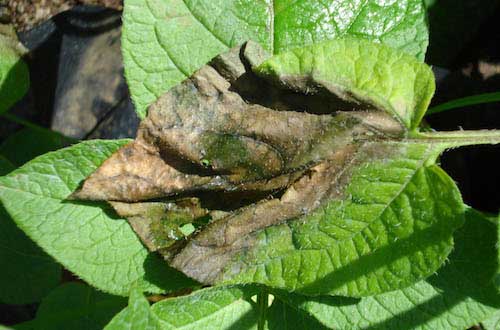Growers urged to be on lookout after Late Blight detected in Genesee County
Press Release, Cornell Vegetable Program

Photo from USA blight
Late blight, a devastating airborne disease of tomatoes and potatoes, was detected in Genesee County on Tuesday. Late blight is best known for causing the Irish Potato famine. Late blight is caused by a fungus-like organism that spreads dozens of miles on storm fronts.
Late blight can kill plants in just one week. Disease spots are often dark gray to brown in color and may or may not have a ring of pale green tissue around them. They are typically irregular in shape and size, and frequently become as large as a quarter. Leaf spots will often have small fuzzy white spores on the underside of the leaf in wet and humid conditions.
Late blight will put dark brown to black smears on plant stems. Tomato fruit may also develop large, firm, greasy-looking, brown, gray, or black smears on the upper part of the fruit. Late blight does not resemble lower leaves that yellow and contain numerous small black specks. Potato leaves show dark spots with fuzzy white spores on the underside during humid weather. Potato stems show similar lesions to those seen in tomato.
As this disease is aggressive and very damaging to area farmers, Cornell Cooperative Extension asks that anyone suspecting they have late blight please contact their local CCE office for assistance. In Orleans County, the office can be reached at 585-798-4265. Commercial vegetable farmers may contact the Cornell Vegetable Program at 585-406-3419.









































































